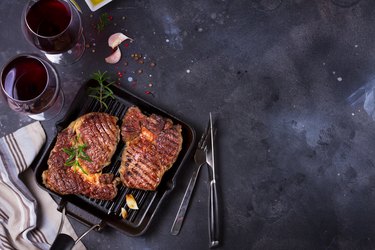
When it comes to steaks, New York strip versus rib-eye are both considered premium cuts of meat and cook well on the grill or under the broiler. Both cuts sell for approximately the same price in markets, and both result in flavorful meals.
When determining which is the better cut of meat, it all comes down to personal preference.
Video of the Day
Video of the Day
Tip
When deciding between New York strip versus rib-eye, it comes down to personal preference. Both are premium cuts that cook well for a flavorful dish.
New York Strip vs. Rib-Eye
Also called Kansas City steaks, top loin steaks or strip steaks, New York steaks come from the short loin portion of the beef, situated between the rib and the sirloin.
In T-bone steaks, the bone separates the New York portion of the steak from a piece of tenderloin. Consequently, New York steaks can be sold with a narrow bone on one side or boneless.
Rib-Eye steaks come from the rib portion of the beef, immediately forward of the short loin and behind the chuck. Because the rib portion of beef rests between major joint and movement areas, steaks from this portion contain rich fat marbling.
This fat marbling helps rib-eye steaks remain tender and juicy when cooked. According to the USDA, a 3 ounce serving of cooked rib-eye steak, trimmed of excess fat contains 17.9 grams of fat.
Make Your Choice
New York steaks contain less fat and marbling than rib-eyes, so choose New York cuts for a leaner steak that may satisfy dietary restrictions or personal preference.
According to the USDA, a 3 ounce serving of cooked New York strip steak, trimmed of excess fat, contains 10.6 grams of total fat.
Rib-eye steaks provide a deep and rich flavor from the high fat content and aren't quite as easy to dry out by overcooking, a plus for beginners.
Because of the high fat content, rib-eye steaks cook down a bit more than New York steaks, as the fat gets rendered into liquid form and dispersed.
Because New York steaks retain more of their precooked weight, the price per pound of cooked meat becomes slightly less than that of rib-eyes.
Read more: How to Cook a Tender Steak on the Stove
Try These Tips and Tricks
When preparing New York steak, brush a bit of olive oil, add salt and pepper and allow them to come to room temperature for about 30 minutes before cooking.
Pan-sear, grill or broil them on high heat for up to five minutes per side, or until a meat thermometer registers 145 degrees Fahrenheit in the thickest part for medium-rare. This is also the minimum safe temperature for steak consumption, according to the USDA. Be careful not to overcook New York steaks.
Prepare rib-eye steak with salt and pepper, but skip the olive oil. The higher fat content in rib-eye steaks keeps them from sticking to the grill or pan.
Cook rib-eye steak in the same way as New York steaks, but because this cut is slightly more forgiving, allow guests to choose their own level of doneness.
- USDA FoodData Central: "Beef, Rib Eye Steak, Boneless, Lip Off, Separable Lean and Fat, Trimmed to 0" Fat, Choice, Cooked Grilled"
- USDA FoodData Central: "Beef, Loin, Top Loin Steak, Boneless, Lip Off, Separable Lean and Fat, Trimmed to 0" Fat, Choice, Cooked Grilled"
- USDA: "Safe Minimum Internal Temperature Chart"
- Providence Health & Services: New York Strip Steak Salad
- The Splendid Table: Rib-Eye Steak with Chimichurri and Patagonian Potatoes
Was this article helpful?
150 Characters Max
0/150
Thank you for sharing!
Thank you for your feedback!